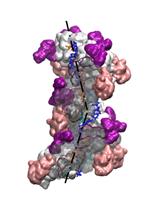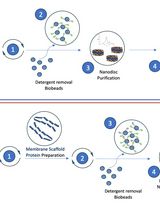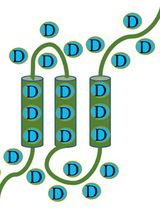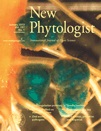- Submit a Protocol
- Receive Our Alerts
- Log in
- /
- Sign up
- My Bio Page
- Edit My Profile
- Change Password
- Log Out
- EN
- EN - English
- CN - 中文
- Protocols
- Articles and Issues
- For Authors
- About
- Become a Reviewer
- EN - English
- CN - 中文
- Home
- Protocols
- Articles and Issues
- For Authors
- About
- Become a Reviewer
Hydroxyproline Assay Using NaBr/NaOCl
Published: Vol 3, Iss 19, Oct 5, 2013 DOI: 10.21769/BioProtoc.917 Views: 10344
Reviewed by: Tie Liu

Protocol Collections
Comprehensive collections of detailed, peer-reviewed protocols focusing on specific topics
Related protocols

Modeling Perturbations in Protein Filaments at the Micro and Meso Scale Using NAMD and PTools/Heligeom
Benjamin Boyer [...] Chantal Prévost
Jul 20, 2021 3448 Views

Optimizing Transmembrane Protein Assemblies in Nanodiscs for Structural Studies: A Comprehensive Manual
Fernando Vilela [...] Dorit Hanein
Nov 5, 2024 2975 Views

Protein Structural Characterization Using Electron Transfer Dissociation and Hydrogen Exchange-Mass Spectrometry
Rupam Bhattacharjee and Jayant B. Udgaonkar
Jun 20, 2025 1726 Views
Abstract
Hydroxyproline (Hyp) is a major constituent of a relatively few proteins that are major structural components of the extracellular matrix and primary cell wall of animals and plants respectively. Significant amounts of the cyclic amino acids proline and hydroxyproline decrease polypeptide flexibility; thus proline/hydroxyproline-rich proteins are ideal scaffold components. Collagens typify animal tissues but extensins, arabinogalactan proteins (AGPs) and their close relatives, collectively referred to as hydroxyproline-rich glycoproteins (HRGPs), typify plants (Lamport et al., 2011). While collagens are minimally glycosylated generally via a galactosyl hydroxylysine linkage, plant HRGP glycosylation involves short neutral oligosaccharides (in extensins) or much larger acidic polysaccharide substituents (in AGPs) O-linked via the hydroxyproline hydroxyl group. Hydroxyproline assay is thus an integral part of their characterization and dominates the biochemical properties of these glycoproteins. The colourimetric assay described here quantifies free hydroxyproline (e.g. released by acid hydrolysis) based on Kivirikko and Liesmma (1959) with hypobromite as an oxidant but modified by avoiding the use of hazardous liquid bromine. A number of oxidants have been used over the years, Vogel (1961, page 395) explains the preference for hypobromite as follows: “Hypochlorites tend to react slowly with reducing agents. Hypobromites although rather unstable when prepared directly from bromine and alkali, often react more rapidly; it is therefore advantageous to produce hypobromite in situ by adding an excess of bromide to the sample of hypochlorite:” OCl- + Br- → OBr- + Cl- “By this means the relative stability of hypochlorite is combined with the more effective oxidizing properties of hypobromite.”
Materials and Reagents
- NaOCl (Lab bleach)
- NaOH
- NaBr
- 6 N HCl
- Dilute hypobromite
- p.dimethylaminobenzaldehyde (Sigma-Aldrich, catalog number: 156477 )
- n.propanol (Sigma-Aldrich, catalog number: 402893 )
Equipment
- 2 ml screw-cap microtube (SARSTEDT AG)
- Microplate reader or spectrophotometer
Procedure
- Prepare dilute sodium hypobromite (NaOBr) from NaOCl, mix equal volumes (a) + (b) (e.g. 5 ml each) (prepare fresh weekly-store at 4 °C).
- Add 775 μl lab bleach to 10 ml 4% NaOH (fresh weekly).
- Prepare 100 mM NaBr (1.03 g in 100 ml 4% NaOH) (stable).
- Add 775 μl lab bleach to 10 ml 4% NaOH (fresh weekly).
- Add 250 μl aqueous sample to 2 ml screw-cap microtubes (e.g. SARSTEDT AG).
- Add 500 μl dilute hypobromite to:
- Analysis samples each in 250 μl distilled water.
- Hyp standards of 2.5, 5.0, 7.5 and 10 μg, each in 250 μl distilled water.
- A reagent blank contains reagents plus an additional 250 μl distilled water.
- Analysis samples each in 250 μl distilled water.
- Mix and leave for 5 min to oxidize at room temperature.
- Add 250 μl 6 N HCl.
- Add 500 μl 5% p.dimethylaminobenzaldehyde in n.propanol (total volume = 1.5 ml).
- Mix and heat at 70 °C for 15 min, then cool in ice-water.
- Measure absorbancy of samples and standards at 560 nm against the reagent blank. e.g. 10 μg Hyp → ~680 mAUs
- Construct the standard curve and calculate sample values by interpolation.
Recipes
- This assay determines free hydroxyproline, best prepared by hydrolysis peptide bonds in the sample to be analysed (6 N HCl at 110 °C for 18 h) followed by removal of HCl in vacuo and redissolving the hydrolysate in distilled water. Interestingly free O-glycosylated Hyp can be assayed directly.
- Use aqueous Hyp standards over a 2.5 to 10 μg range. It is convenient to prepare a Hyp standard of 100 μg/ml in distilled water stored frozen; mix well after thawing! The reagent blank contains all the reagents with distilled water as a substitute for the sample.
- 5% w/w p.dimethylaminobenzaldehyde in n-propanol.
Acknowledgments
This protocol is adapted from Kivirikko and Liesmaa (1959) and Lamport et al. (2012).
References
- Kivirikko, K. I. and Liesmaa, M. A. (1959). A colorimetric method for determination of hydroxyproline in tissue hydrolysates. Scandinavian J Clin Lab 11(2): 128-133.
- Lamport, D. T., Kieliszewski, M. J., Chen, Y. and Cannon, M. C. (2011). Role of the extensin superfamily in primary cell wall architecture. Plant Physiol 156(1): 11-19.
- Vogel, A. I. (1961). A text-book of quantitative inorganic analysis. 1-1216, Third Edition. Publisher: Longmans.
Article Information
Copyright
© 2013 The Authors; exclusive licensee Bio-protocol LLC.
How to cite
Lamport, D. T. A. (2013). Hydroxyproline Assay Using NaBr/NaOCl. Bio-protocol 3(19): e917. DOI: 10.21769/BioProtoc.917.
Category
Biochemistry > Protein > Modification
Biochemistry > Protein > Structure
Do you have any questions about this protocol?
Post your question to gather feedback from the community. We will also invite the authors of this article to respond.
Share
Bluesky
X
Copy link









